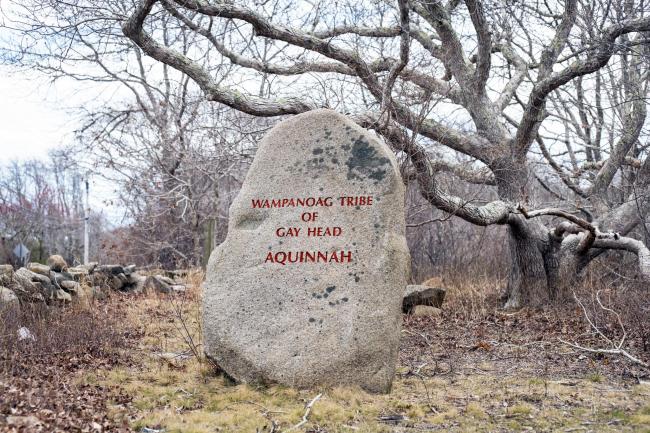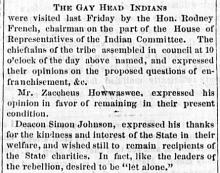A collection of old documents dating far back in the last century has been unearthed in the old Jeffers house at Gay Head by Lorenzo D. Jeffers, the present owner of the estate of his ancestors. These documents consist of letters, ledgers, bills and notations kept by Thomas Jeffers, grandfather of the present owner.
Thomas Jeffers, according to the documents, served Gay Head as clerk and treasurer during the years, when it was a district and previous to its incorporation as a town. That Gay Head held town meetings then and elected town officers is shown by copies of several warrants which were posted to warn the inhabitants of meetings and elections and these were signed by the selectmen. The names of George Belain, Aaron Cooper, Zaccheus Cooper, Zaccheus Howasswee, Charles Mingo and others are signed to these warrants.
The need for a treasurer and clerk is shown in the volume of business that was transacted by the district in those days. Gay Head owned large tracts of public lands which included grass land where hay crops were harvested, pasture lands which were rented, and clay deposits which were under development and from which the town sold much of the material. All this business was transacted under the direction of Thomas Jeffers, who handled the correspondence and received the fees and other funds, also making payments for labor and other services, all of which are duly recorded. There is no indication of what his salary might have been for all the duties he performed, but while serving as a selectman his salary was $28 annually.
Welfare Problem Was Considerable
The notations in his ledger are many, varied and puzzling in some instances. It is fairly evident that the district had a welfare problem that was considerable even for those days, and it seems also apparent that in case a person receiving welfare owned real property, this was sometimes sold under the direction of the district treasurer and the money applied to the support of the seller. Whether or not there were such things as taxes cannot actually be determined from the entries, but it would appear that some sort of assessment were made against landowners, and there were many bills against purchasers of marsh hay, pasturage and the like, which were balanced by their own bills against the town for labor in mining the clay, hauling it to the dock and assisting in loading the vessels which carried it away.
Zaccheus Howasswee, whose name is frequently seen, settled a bill for marsh hay, also for the rental of “Moninshire Beach” and for one “mill sail.” This is one of the rare references to windmills on Gay Head. “Daniel Nevers, dr. for 2 acres of land to the north of his homestead, at 4 dollars per acre,” reads another entry. This is followed by another: “Abram Rodman bound to if Daniel Nevers did not in a reasonable time.” A trifle confusing, but three years later another entry partially explains. “Order for 13.00, Eight dollars of the above order hoped to pay for the two acres of land of Daniel Nevers.”
Pasturage was leased or rented to various people of the Island and the names of residents of Chilmark, West Tisbury and Edgartown are carried on the books, which are neatly kept.
The county appears to have paid a share in the expense of maintaining the Gay Head school and seemingly the school was in session for a greater portion of the year than was usual at the time in the other Island towns. Thus the ledger states that “60 dollars were received from Smith Mayhew for school money” and again, “20 dollars were received.” Bills for books and for teaching are marked “for summer school” in several instances.
Those were industrious men in Gay Head at that time. Rev. Mr. Sawyer, the pastor, painted the parsonage himself and sent in a bill to the district for $4.55 which was paid.
The welfare department, whatever it may have consisted of, dealt locally as far as possible and kept its own counsel, for the records fail to reveal how many of the recipients of aid might have been, an din the case of one who was evidently ill or insane, and was removed to a mainland institution, no name is given. But the bill for taking the patient to the mainland is made out in utmost detail, showing where the patient was lodged en route, how much was paid for lodging, for travel to and from the depots and between towns. The price of meals and all other matters is carefully set forth and the whole sum total $26. Apparently several days were required to accomplish the service.
Coffins at $3 Apiece
A quilt “for the poor” was purchased from a local resident for two dollars, and several bills for coffins for the poor were for three dollars each. The coffins were made be men of the district whose names are given.
The adherence to ancient customs by the Gay Head people is seen in the warrants for their public meetings and elections of the time. In addition to choosing all regular officers such as a town has today, they chose agents to handle the town lands, to lease, rent and sell the same, to repair the town fences, take charge of the town cranberry bogs and perform other duties which appear strange indeed today. Further, they voted on the location of a “planting-field” and “chose a watch to keep the sheep off.” As far back as 1866 they brought up the subject of bridging Menemsha Creek, but the old documents fail to show what action was taken.
The names of Walmsley, Nevers, Gerard and Silvia, of Howasswee, Mingo and Rodman appear frequently. None bearing any of these names reside today in Gay Head, although members of some of the families are still living elsewhere.
The collection contains many old letters, some carried by messenger, some bearing stamps and others showing simply a cancellation and receipt of payment of postage. Some statistics compiled in 1807 are of interest. “There are,” says the statement, “seven wigwams in Gay Head, 26 framed houses and 34 families. Of souls, 142 and about one hundred more are absent, being children bound out to service in English families and mariners at sea.”
A log book of the ship Mary of New Bedford is also included with the papers, a rather dry-reading account of a lengthy voyage in the North and South Atlantic, Indian Ocean and so around the globe. Many whale were taken, as the stenciled silhouettes reveal, but these were taken within a period that was outstanding in the voyage and the greater part of the time was spent in routine ship duty. Thomas Jeffers is known to have sailed as chief officer of this ship at one time, but the log has been partially destroyed and it cannot be shown that this was his. The date, 1840, supplies the only clue.
The Sea Was Always Friendly
But whoever he was, he was a man among men, and if it was indeed Thomas Jeffers, he was probably eminently fitted to handle town affairs. His entries in the log book, made with frequency, refer to weather and the carrying of sail in the words of a man who loved seafaring. “Pleasant gales,” he wrote or “favoring gales, set the topsails, double-reefed,” or “light gales from the South, set the lower studding-sails.” He speaks of rough weather and rising seas, but not once does he say that the weather was downright bad. It was windy, yes, but the wind was fair for the most part and kept the ship logged off the knots before it. A sketch of the landfall at Sandlewood Island is cleverly done in the book with pen and ink. A versatile man, Thomas Jeffers, and one who inspired respect.










Comments